- All
- About Soaring
- Badges & Records
- Camps
- Convention
- Costs
- Getting Started
- Racing
- Ratings
- Robertson Trust
- Safety
- Safety Seminar
- Scholarships
The answer is yes. For Diamond Distance tasks an official observer and flight recorder are required. Official Observer: An Official Observer is a member of SSA who holds at least an SSA B Badge, and has a working knowledge of the FAI Sporting Code as it pertains to gliders.
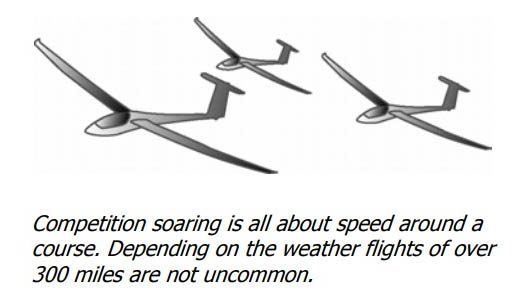
Yes! The sports national organization, the Soaring Society of America, sanctions both regional and national soaring competitions in the United States. A sailplane competition typically lasts five to ten days, with tasks set each day the weather is suitable. Each contest features flights from the home airport, around turnpoints, and back to the home field.
In poor weather, the course might be as little as 60 miles; in excellent weather it could be 350 miles or more. Competitive soaring is all about speed, with the fastest pilot around the course receiving the most points for the day. The contest winner is the pilot with the most points at the end of the event. Seconds count and on some days may make the difference between winning and losing. Regional competitions are held all across the country, typically lasting 5 to 7 days and involving 25 to 50 gliders in several competition classes. National Championships run for 10 days and usually include 50 to 65 competitors. A handful of pilots from the national level are selected to compete internationally at World Soaring Championships on United States teams.
Of course. Thankfully, and unlike hang-gliding or skiing for that matter, small injuries like broken wrists are unheard of. Many instances of major damage to gliders result in no injury to the pilot or passengers, furthermore. However, fatal accidents can occur, the incidence being less than a dozen per year in the USA out of tens of thousands of participants and hundreds of thousands of flights. The major cause is pilot error, followed by weather extremes. Mid-air collisions are rare, equipment failures are rarer still, and usually due to pilot preparation mistakes rather than structural weakness.
Altitudes are typically above 1,000 ft., that space being reserved for launch and landing.
Typical flight speeds are about 60 mph but can be as high as 160 mph and as low as 30 mph.
Sailplanes come in single-seat and two-seater varieties, setting aside a rare two-passenger ride machine or the troop gliders of World War Two. On average, they span 60 ft., and measure 25 ft. from nose to tail.
On average, they weigh 600 lb.
Sailplanes only take a few minutes to assemble. The following sequence shows a high performance sailplane being assembled. After the sailplane is assembled the pilot carefully checks over all the flight systems in what is referred to as a pre-flight check. The entire process from driving up to the airfield to being ready for launch can take only 30-45 minutes.

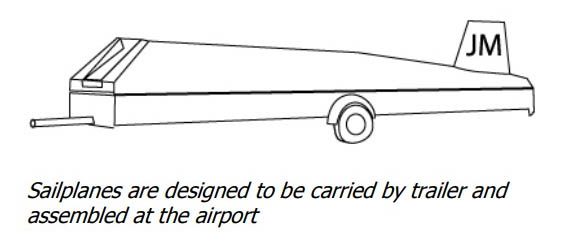
All sailplanes are designed to be disassembled and trailered. The wings and tail are removable and slide securely into a special trailer for the trip to the airport and back home after the days flying. Sailplanes are designed to be carried by trailer and assembled at the airport Assembly normally takes a few minutes from start to finish and can be done with two people in most cases. The heaviest part of the sailplane that needs to be lifted during assembly is the wings which typically weigh just over 100 pounds.

Stronger. In the USA, the FAA certifies Approved Type aircraft into strength categories of “Normal”, Utility” (a little stronger), and “Aerobatic”. All gliders are at least “Utility” and many “Aerobatic”. With smaller payloads and no engines to support, it is reasonably easy to engineer glider airframes strong.
Typically, the same as for light airplanes. In the USA, the Federal Aviation Administration (FAA) sets certification requirements for gliders and their pilots, including annual equipment inspections and pilot currency checks. The NTSB and NASA maintain accident reports.
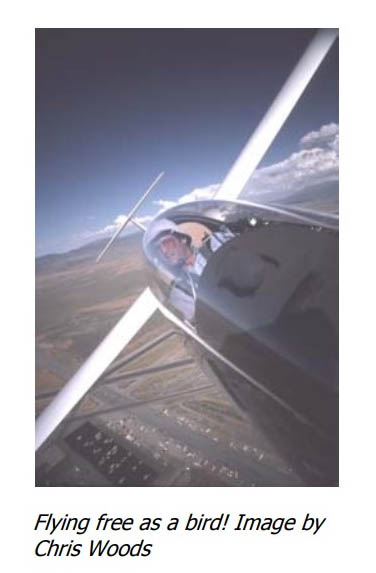
Almost all flights do. A typical commercial glider ride of half an hour will roam around the airport a few miles and return to land within a few feet of the takeoff point, ready for the next passenger. Through the 1960s, a tailwind boosted all the longest record and contest crosscountry flights and the fashion was to head off followed by a ground crew, like balloon pilots. Given the distances of over 500 miles then achieved and the long return trips, and adding in the energy crisis fuel difficulties of the early 1970s, the fashion has since universally turned to closed-course flights.
No, sailplanes usually fly faster than the wind. Accordingly, a flight can be conducted upwind of a
home airport almost as easily as downwind. In fact, pilots of lower performance gliders are best
advised to stay upwind of the airport at all times as the altitude needed to return to the field is far less.
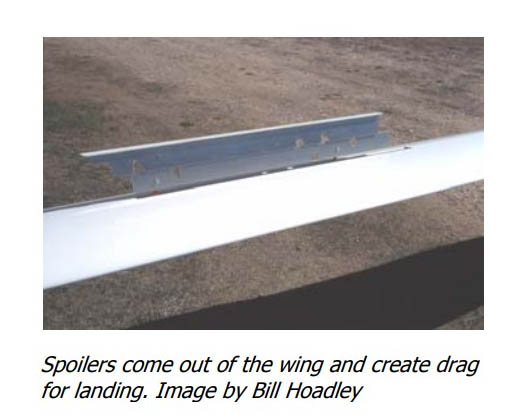
With dedicated glidepath controls. Since the 1930s, when gliders were routinely becoming slippery sailplanes (glide ratio over 20:1), it has been standard practice to fit airframes with devices to decrease lift, increase drag, and steepen the glide. Most popular are wing top surface “spoilers”, narrow blades that swing out perpendicular to the airflow, but various schemes of dive brakes, flaps, and even drag parachutes have been employed. With the continuously adjustable pull of a cockpit handle, a sailplane gliding at 60 mph and at a shallow 150 feet per minute (fpm) down (40:1) can be turned into a brick dropping at 1,500 fpm (4:1). Enough control to defeat storm currents and land exactly where desired.
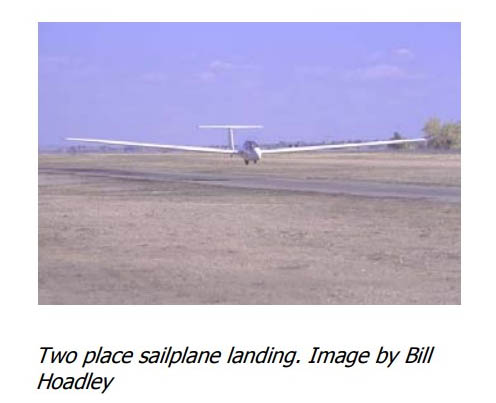
You glide on to a landing. From 2,000′ up (a typical tow release altitude), a sailplane can stay airborne some 10 minutes and travel some 10 miles in the process. With a little planning, it is not too hard to find an airport at which to land. If need be, any number of farm fields can be landed in safely as sailplanes touch down at 40 mph and roll 400′, with little tendency to tip over like airplanes. Sailplanes grounded at a distant location are designed to be disassembled and loaded into trailers in a matter of minutes. Some wealthier pilots like to order small retractable “sustainer” engines installed in their machines, with just enough power and range to motor home. Still, having a trailer as part of one’s kit provides a portable hangar for storage and a convenient means to relocate the glider at another site
Yes, mainly summer. Thermals are the most common source of lift, and weather patterns and sun angles favor them in the Summer. Some pilots like to soar in the Northern Hemisphere in June and the Southern Hemisphere in December if they can afford the travel. On the other hand, waves and ridge lift are more commonly generated by winter weather patterns, so pilots in hilly areas can enjoy exciting soaring year-’round.
Sun and wind. Given that winds ultimately derive their energy from sunlight, soaring is a solar-powered sport. In order of discovery, the classic forms of Lift are: Ridge: wind deflected upwards by a slope. Thermal: warmed air rising from a hot spot on the ground. Wave: wind compressing and rebounding after passing a slope. Individual thermal convection cells, “thermals”, are ubiquitous on most summer days and make the sport possible all over the world with no need for wind or hills. Combinations of lift mechanisms, such as thermal-induced waves, air mass convergences, morning slope winds, wind shadow thermals, or vortex streets enrich and extend the range of opportunities.
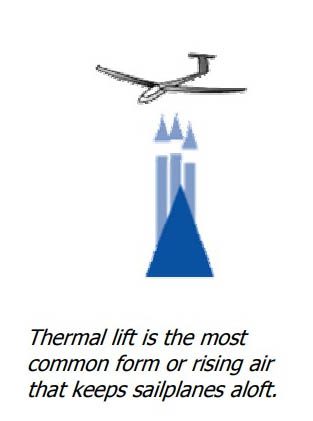
“Lift”, rising air. It is an exercise in relativity: a sailplane typically sinks 200 feet per minute (about 2 mph) through the air that surrounds it. If that air is moving upwards faster than 2 mph, the glider rises relative to the ground. In the early 1920s, glider pioneers were doubtful that consistent large upward currents of 2 mph could reliably develop in the atmosphere and be exploited by pilots. Perhaps soaring was only for the birds, slow and maneuverable as they were. Once they tried, they soon found out that useful lift is quite common and it is a rare day that a glider cannot do at least a little soaring.
With the same aerodynamic controls as light airplanes. Stick (for the right hand) and rudder (for the
feet) are the primary flight controls for speed and direction adjustments. The analog to the throttle for
altitude control is the spoiler handle (for the left hand), although it only increases rate of descent and
cannot enable a climb at will. A release knob allows terminating a tow at any time. More exotic
sailplanes have retractable landing gear, flaps, water ballast tanks, and even auxiliary engines.
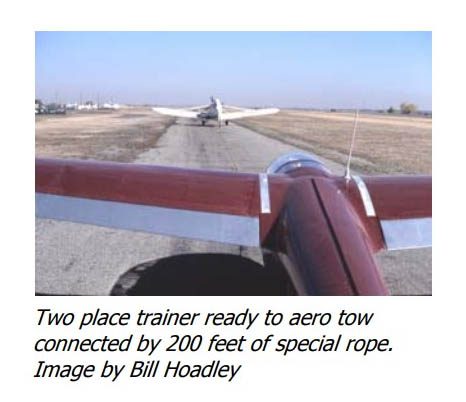
Mainly by aero towing. Aero towing is accomplished by flying in formation with a power plane (tug) on a short rope. The other launching methods include kiting up on a long cable drawn by a winch or car (ground launch). Sometimes, sailplanes also take off with an on-board auxiliary engine (motor launch). Over flat ground, a launch to 2,000′ usually suffices to contact lift. Even a heavy modern sailplane can get to flight speed by being hand pushed or towed down a windy slope, but it amounts to a 1930s nostalgia exercise at the few places it is still done.
Sailplanes have a number controls, surfaces and parts all with their own names. Many of these terms are exactly the same used for all other aircraft. Here are the main parts of a sailplane…
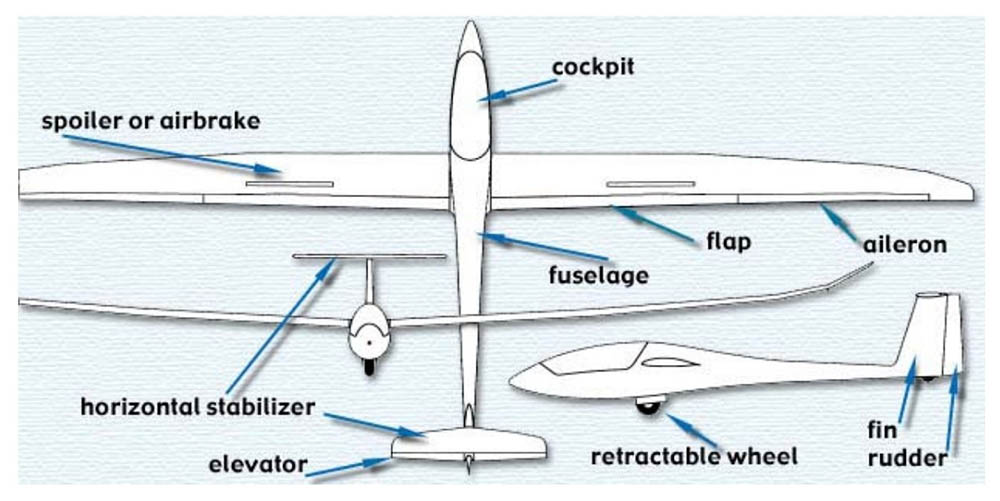
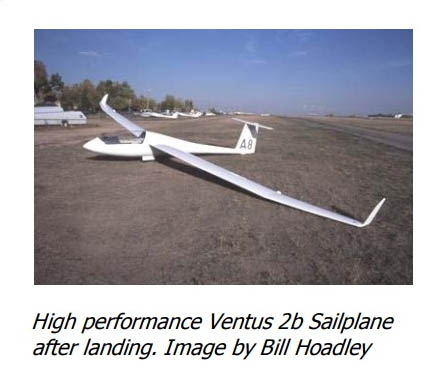
Mainly weight and glide capability. Hang-gliders are designed for lightweight (70 lb.), portability, on a car rooftop, and low cost, usually under $10,000 new. They are mostly flexible wings steered by the pilot shifting their weight. Hang-gliders were originally launched by running downhill solo, although towing by car and ultralight airplane has become increasingly popular.
The newer category of Para-gliders consists of ram-air parachutes that omit rigid elements of hang-gliders (aluminum or carbon fiber tubes) and thereby score even higher on the light, portable, and cheap scales. However, these attributes limit aerodynamic efficiency, and Para-gliders rarely achieve glide ratios greater than 8:1 (8 feet forward for 1 foot of altitude lost), hang-gliders 16:1, whereas sailplanes routinely achieve 40:1.
Compared to hang-gliders and Para-gliders sailplanes weigh much more at between 500 and 1500 lbs., feature a full enclosed cockpit and utilize 3-axis aerodynamic controls. Sailplanes fly considerably faster than hang-gliders or Para-gliders reaching top speeds of 160 mph and sailplanes are certified by government agencies such as the Federal Aviation Administration (FAA). The biggest difference between sailplanes and hang-gliders is performance in which the sailplane is the undisputed king of high performance soaring.
Both. In living memory, mainly the sailplane. The world’s first consistent pilot, Otto Lilienthal, flew a
foot-launched hang-glider by weight-shift control in the 1890s. The Wright brothers’ 1902 glider was
more of a sailplane with its assisted launch and aerodynamic control surfaces. Extensive German
glider experiments in the 1920s started out with hang-glider designs but rapidly evolved to sailplane
configurations for better aerodynamic performance. Hang-gliding revived in the USA in the 1970s as a
low-cost unregulated means of flying, mostly independently of the already thriving sport of sailplane
flying (then and still called “soaring” even though hang-gliding rapidly focused on soaring as well).
It is the same nature sport at a different scale. Technically, sailplanes, hang-gliders, and Para gliders are just different styles of glider used to pursue gliding and soaring for recreation, in the same way that sailboats and windsurfers share the lake and the wind. Each has advantages–from low cost for Paragliders to high efficiency for sailplanes. In practice, the pilot communities are very separate although the USA national associations cooperate fruitfully.
Either one, mainly “soaring”. The term Gliding is used in the United Kingdom and internationally, as in British Gliding Association, World Gliding Championships. The term Soaring is used extensively in the United States as in Soaring Society of America. Technically, “soaring” refers to the act of maintaining or gaining altitude in unpowered flight (aided by rising air). This is what pilots seek to do while gliding down relative to the surrounding air.
Either one, mainly “glider”. A glider is any motorless aircraft, this is the generic and colloquial term used by sailplane pilots themselves. In the USA, the FAA aircraft category designation for sailplanes and motorgliders (motorized sailplanes) is “glider”. The word “sailplane” came about in the 1920s to distinguish refined gliders from “secondary” and lowly “primary” training gliders. Since the 1970s, the term has been useful to mark a distinction from hang-gliders. See the Press Room for a glossary of terminology.
Donations can be done in the name of a business and receive the same tax deduction as personal donations.
Absolutely! A simple line in your will allows you to donate to the Robertson Trust from your Estate. If you wish to donate out of your estate the Trust Manager can assist you in setting this up.
NO! The charter of the Robertson Trust is established to prevent any change in purpose or design. When you donate to the Robertson Trust you can be assured your funds will be working for the team permanently.
All SSA trustees and managers are volunteers. The funds are managed in accordance with the trust’s charter by an approved professional money management firm who may charge a small fee.
In 1997, the Soaring Society of America established the Soaring Society of America Foundation as a unique entity with its own operating by-laws and officers, specifically to facilitate the raising of endowment type funds through planned giving and other contribution mechanisms, for the various SSA Trust funds. The Foundation assumed the management of the SSA Trust Funds with the intent of mounting a strong fund-raising effort for the Foundation
Donations to the Robertson Trust are fully tax deductible under the 503.1B rules. See your tax professional.
YES! There are tangible tax advantages to donating stock and securities to the Trust. Contact the Trust Manager for more information.
You bet! The Robertson Trust accepts equipment at fair market value. Proceeds from the sale of the equipment will in turn be donated to the trust in the name of the original donor.
No. The team is open to all participants who, through talent, drive, hard work and no small amount of sacrifice earn the right to represent the United States at the World Gliding Championships. True, some team members have been financially successful, but selection to a US team is performance based only. Past team members have included teachers, architects, welders and many other professions. With the addition of the Club, World and Junior class, the world championship dream is available to a wide spectrum of US soaring pilots. There is little more discouraging than winning a place on a U.S. Team only to be faced with a $10,000 bill for participating. Our best pilots will loose interest if championship participation means a huge personal bill. Meaningful team funding helps keep this dream alive.
The point of the Robertson Trust is to create and preserve a permanent fund that will sponsor US Soaring teams for generations to come. Any contribution amount is welcome. Every effort is made to keep administrative costs to an absolute minimum.
The World Gliding Championships are the highest expression of competitive soaring. The possibility of world team membership encourages pilots of all levels and from around the globe to strive to be their best. This effort can only energize the overall soaring movement. Beyond the individual and the sport comes the nation. The United States and our nations ideals are held high when we field successful, fully funded teams, at World Gliding Championships.
The Robert Robertson Memorial Team Fund was established in 1988 to memorialize the late Robbie Robertson who was tragically killed in a sailplane accident shortly after winning the 1986 15-Meter National Championships. The Robert Robertson Memorial Team Fund, often referred to as the Robertson Trust, was established by Robbie’s father, Donald Robertson and the Soaring Society of America to provide a strictly dedicated corpus of funding the income from which would be used to help fund the United States Soaring Teams participation in sanctioned World Soaring Championships.
The Robertson Trust is one of several trusts and endowments administered by the SSA Foundation. In 1997, the Soaring Society of America (SSA) established the SSA Foundation as a unique entity with its own operating by-laws and officers specifically to solicit, manage and distribute endowment type funds held by the SSA. The thinking behind the SSA Foundation was that an independent foundation managed by trustees as gatekeepers would be the best way to solicit and manage the various endowments held by the Soaring Society. The clear corporate identity of the foundation structure provides long-term security and stability to contributors while bringing the internal discipline necessary to preserve and manage long term endowments. This means that the income from your contribution to the Robertson Trust will be sending US Team pilots to World Soaring Championships for generations to come.
Unlike many European teams the United States Soaring Teams receives no government assistance and must rely on donations and private funding to participate in the world gliding championships. This hand-to-mouth existence has allowed the US Soaring Team to participate on only the thinnest of margins in years past. The advent of new FAI sanctioned teams has stretched the funding of our teams to the breaking point.
This is an important distinction… There are two primary types of contributions critical to fielding U.S. Soaring teams, direct and perpetual. Direct contributions are fully available for use by the teams while contributions to the Robertson Trust are invested, with the income from these contributions providing perpetual support but at a lower per year return when compared with direct contributions. Both direct and perpetual contributions are critical to insuring our soaring teams can participate internationally. The challenge with the Robertson is to build the trust and restore the balance between direct and perpetual funding.
Competitive soaring rewards excellence while providing some of the spark that keeps our sport going. Many of the astounding improvements in equipment and techniques our sport has enjoyed over the years can be traced back to a need for competitive excellence. Most of the used single place gliders in this country were imported originally by competition pilots.
Competitors tend to be among the most active participants in our sport, often shouldering key roles on a local, regional and national level. The drama of international competition is the ultimate expression of competitive excellence as the worlds best soaring pilots compete for the title of World Champion.
For many nations, including the United States, fielding soaring teams to compete internationally is a point of national pride within the countries soaring movement.
So if, fostering competitive excellence, helping to spark participation, appreciating the international competitive drama and holding our nation’s place in soaring high are not enough, there is this. The simple fact is that not all competition happens in the air. Adequately funded teams are in a much better place to compete and win against the world’s best.
- Glider accident analysis
- Preventing aerotow accidents
- Effective scenario-based training
- Landing accidents and emergency preparedness training: Is there a link?
- Sinking airmass and its role in glider accidents
- Soaring site surveys and accident prevention
- Detecting and correcting gaps in your club’s flight training program
- Preventing stall/spin accidents through landing task analysis and recurrent training.
- Other topics may be substituted or included at the request of the hosting organization.
That depends on the demand. The target is six and if money is available to continue to subsidize the program, the number of seminars may grow in future years.
- Your organization must cover any/all on-site costs (meeting room, light refreshments if deemed appropriate, chairs, a white surface to project PowerPoint shows on, and so on). In many cases, these expenses will be very low if members work together in volunteer fashion to reduce on-site expenses.
- Your organization pays a flat fee of $300.00 to the SSF to help defray the cost of bringing the Safety Seminar to your city. SSF will more than match that amount to bring the Safety Seminar to you. When you add up all travel expenses alone, you can see that the actual cost of a Seminar far exceeds $300. The SSF subsidizes these Safety Seminars because SSF Trustees deem them effective accident-prevention tools.
If 30 club members attend the presentation, the cost per person is $10 – a fraction of the cost of a single aerotow launch. Not a bad deal!
- Consult with the Soaring Safety Foundation to select a suitable date for your Safety Seminar
- Publicize and promote the event locally
- Provide a meeting room suitable for lecture/PowerPoint presentations, and Fill the meeting room with glider pilots, glider pilot wannabes, and tow pilots to attend the Safety Seminar.
Yes, the SSA negotiates with the hotel a bulk rate and provides a group code a few months prior to the event. These rates vary depending on the hotel.
Early Registration (Before Jan 17th) is $100 for all sessions & $50 for family members
Late Registration (After Jan 17th) is $125 for all sessions & $65 for family members
The students are usually flying every day depending on the weather. Daily goals of flying 2.5 hours and up to 150 miles are typical for cross-country camps.
The camps can run up to 7 days. The length of the camp depends on the host club.
The camps can be no more than 20 students.
For Camp Events, a mentor is an experienced pilot that the student is assigned to at the camp or an adult that is accompanying them during the camp.
For all camps, if a youth is under 18, they are required to be accompanied by a parent, guardian, or authorized chaperone for the duration of the camps.
The minimum age for cross country camps is 14 and the student must have already soloed. Students should have earned their A, B, C and Bronze badges in order to attend. Depending on the host club, the Bronze badge that maybe something the camp works on.
The minimum age for contest camps is 16 and would like to see they have their private pilot’s license. If a youth has their own glider they have to hold their private pilot’s license. All others will be flying duo. The duo sailplanes are usually owned by the host club and also privately by pilots willing to fly with the students.
Cross Country Camp Cost: $250.00 Entry Fee
This covers meals for up to 6 days, includes camping, shower and bathroom facilities. Also covers tow fees of up to $55.00 one per day for up to 6 days.
Contest Camp Cost: $250.00 Entry Fee
This covers meals for up to 7 days, includes camping, shower and bathroom facilities. Covers tow fees of up to $55.00 per day for up to 7 days. SSA sanction fee is waived.
Event Camp Cost: Vary
Event Camps are put on by local Chapter/Clubs and vary depending on the length and event topic.
- Demonstrates commitment to soaring by contributing through both flying and non-flying activities and is known for being willing to help with anything.
- Demonstrates a strong interest in aviation and had specific, measurable, achievable, results-focused, and time-bound (S.M.A.R.T) goals related to soaring.
- Includes a personal statement that explains how they will use the scholarship. Ideally, this is a project or goal that relates to the item above.
- Has various skills and talents and uses them to promote their club, soaring in general, etc.
- Ideally, demonstrates a financial need for the award (this should NOT discourage anyone from applying)
- Read the award biographies in the section above for all of the awards that you are eligible for.
- Find a mentor (at your flying club/operation, school, family, etc.) who will read your application completely and help you revise it.
- Ask for reference letters several weeks before the application is due so that they are well written and not rushed.
- The scholarship selection committee is looking to invest the money in people who have earned these awards through their contributions to soaring. Give specific examples of things you did that benefit the soaring community. Some common examples:
- Instead of saying: “I help get gliders ready”, try: “Every weekend I help with/conduct pre-flight inspections, clean the canopies, wipe the wings, and walk the gliders to the flight line for others.”
- Instead of saying: “I talk about gliders at school”, try: “During my Science class, we had to give presentations on (insert topic here) and I shared the story and photos of my first glider ride and a summary of how gliders fly.”
- Convince the scholarship selection committee that you love glider flying and that you have a plan to use the scholarship money. If applying to use the money for flight training, don’t leave the scholarship committee wondering what club you will be flying at, how you will get there, etc. If applying for the Bultman, be creative with your application and intended use – some ideas to get started might be: going to fly cross country or wave camp or contest, going to fly at a new location (maybe not even in the US), taking friends for rides, getting a winch/aerotow/motorglider endorsement, etc.
Start and finish points for badges are only required for diamond goal flights. For records, triangle flights and goal flights require you to cross the same 1 km line used at the start for your finish. For other records start and finish points should be declared but can be release or MOP stop or landing or MOP start. On free distance flights, your start and finish points are selected post flight.
The standard hard right turn after release from tow plane or winch determines the release point. If using a motor glider – the MOP recording determines when the engine is stopped or started. Be sure to test that this variable is working correctly before attempting any badge or record flight. If your motor is running and not recording, your flight would be invalidated. This is especially an issue with electric engines that may not record.
OLC data cannot be used for badge or record flight. Original IGC file is required. OLC data is valid for Kolstad award flights.
Flight recorders must be calibrated every 5 years or within 2 months after every flight.
Badge flights must be submitted within 6 months of the flight. State records must notify badgeandrecords@ssa.org within 10 days of the flight and postmark or email documentation within 45 days of the flight or within 15 days of required post-flight calibration. US national and international record flights must notify badgeandrecords@ssa.org within 48 hours of the flight and mail original documents postmarked within 45 days of the flight or within 15 days of required post-flight calibration.
Notification must include the following:
1) Names and SSA numbers for pilot(s) and observer
2) Start point location (city/airport and state)
3) Sailplane type
4) Record category and class
5) Record type
6) Record claim (include values)
7) Date of flight (UTC finish time)
In most cases if you meet the minimum requirements for each task you can apply for multiple completions at different badge levels or different records in multiple record categories or types.
Any SSA member with at least a B badge may act as observer, or be the airport manager, or be appointed by badgeandrecords@ssa.org.
Contact badgeandrecords@ssa.org to complete an open book exam on sporting code. You must also have some experience as observer or show the completion of badges or records. You will be specifically authorized in writing for a period of three years and can be renewed on request.
A passenger is not allowed on badge and most award flights. A passenger is allowed on record flights and will be listed on the certificate or state records. If it’s for a US national or international record the passenger will be listed if both pilot and passenger have current sporting licenses. You may have a passenger on the Symons award flight and both will receive the pin if the fee has been paid.
Your observer should be able to help with that, and for further information you can contact badgeandrecords@ssa.org.
You can find them on the Badges or Awards Page. All information on Sporting code, approved flight recorders, applications for badges and records, Badge instructions, State record applications, Kolstad Application, SSA distance award application and World Distance award information and application. Be sure to refresh your browser to bring up the most current documentation and not an old one you used before.
An FAI sporting license is required for all record attempts (except state records) and all FAI sanctioned events and competitions. Sporting license applicants must be a member of NAA and/or a current member of the appropriate NAA air sport organization. NAA members participating in competitions and/or record setting activities can receive a one-year FAI sporting license at no cost but must complete and application for the sporting license. You can apply for a sporting license here: https://naa.aero/membership/fai-sporting-license.
Electronic flight data and a DECLARATION are required except where specifically exempt. For the details regarding each different type of badge claim, See the current FAI Sporting code for Gliding, Sections 1.4 and 2.3”.
For badges, state and US national records, you may email badgeandrecords@ssa.org with the name, address, email and phone number of anyone that will be with you – wife, friend, etc. and you will receive authorization to use that person as observer. Review the observer procedures in the sporting code.
There are no declarations required for any silver badge task.
Most instructors feel that 30 to 35 flights are the minimum needed for most people with no previous flight experience. An experienced power (airplane) pilot can generally solo a sailplane in less than 10 flights. Gliders and glider pilots are regulated by the Federal Aviation Administration (FAA) who set the minimum requirements for pilot certificates.
The cost to become a Private Pilot-Glider varies greatly from person-to-person depending on the amount of time needed to master the necessary skills. In addition, each soaring club offers different rates both for instruction and for aircraft rentals. Call your local soaring club for detailed information.
Most gliders typically do not have a propellor and are launched by an aerotow, that is they are pulled by a rope up to about 2,000′ by another power-driven aircraft. Once airborne, a glider or sailplane uses only atmospheric uplift (rising air) to gain height and can usually fly faster than the wind. Soaring is the art of developing skills and knowledge as a pilot to use this rising air for flight.


